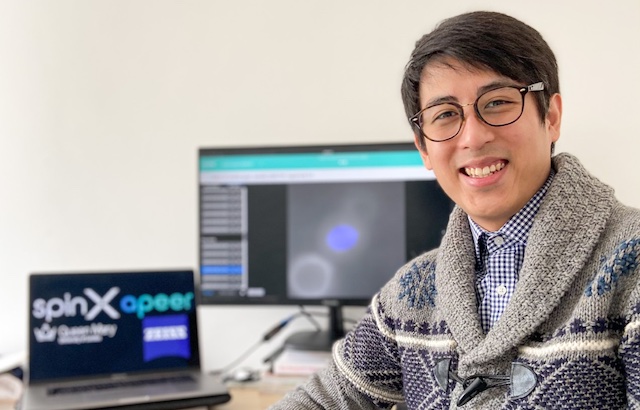Advancing automated analysis of microscopy videos with Zeiss
Queen Mary has been awarded a Knowledge Transfer Partnership with Carl Zeiss, which will allow the company to enhance and expand their state-of-the-art deep learning tools on the APEER cloud-based digital image processing platform.

David Dang, a PhD student in the Draviam Lab at Queen Mary, developed SpinX to track subcellular structures.
The Knowledge Transfer Partnership (KTP) scheme helps businesses in the UK innovate and grow by linking them with an academic or research organisation and a graduate. This helps businesses bring in new skills and academic thinking to deliver a specific, strategic innovation project through a knowledge-based partnership.
This KTP – funded by Innovate UK and Carl Zeiss – will allow the company to address emerging needs in automated image analysis solutions on their cloud-based platform, APEER. This will give APEER new functions to support customers keen on analysing 3D images and movies of cells and tissues.
"As the pioneer of science in optics, ZEISS continues to challenge the limits of our imagination. With our passion for excellence, at ZEISS we create value for our customers and inspire the world to see things in new ways."
- Oliver Clarke, Head of Division at Zeiss Research Microscopy Solutions.
This partnership between Zeiss and the Draviam group emerged during a three-month Biotechnology and Biological Sciences Research Council-funded professional internship placement of David Dang at Carl Zeiss.
To tackle a significant gap in automated analysis of microscopy movies, David has combined deep learning methodology and mathematical modelling to develop SpinX. The innovation lies in the generation of high-quality image data combined with modelling approaches to automatically track subcellular structures in 3D.
Through an Engineering and Physical Sciences Research Council-funded Impact Acceleration Award to the group, SpinX is being implemented on APEER. Principal Investigator Professor Viji Draviam at the School of Biological and Chemical Sciences said, “Generalising SpinX and extending it on APEER, through the KTP, will make the knowledge accessible to bioscientists without the need for computing expertise. Moreover, it has the potential to transform high-throughput imaging-based drug screens by allowing automated video analysis – a competitive space for pharma and biotech industries.”
SpinX will be extended to multicellular structures during the KTP by working with Dr Chema Martin, an ERC early career investigator studying annelid development.
This KTP partnership is supported by Queen Mary’s Business Development team, which works to connect the University’s academics with private-sector organisations that can benefit from world-class research expertise.